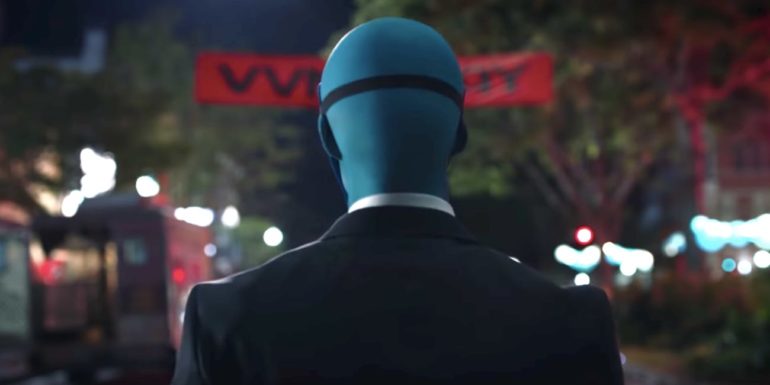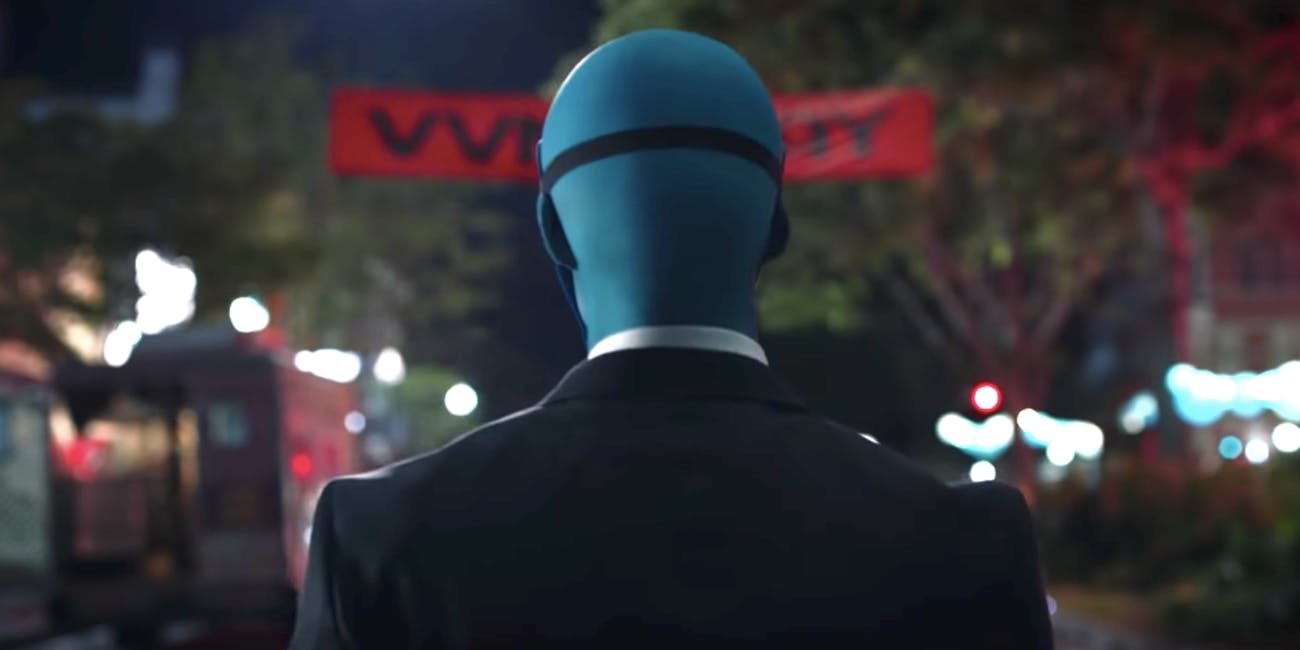“Did you know that time/
Is not a straight line?”
– Solar Winds, Devin Townsend Presents Ziltoid The Omniscient
Before anything else, me and my little friends at the Welsh Tourist Board would like to express quivering, impotent outrage at the multiple incidents in ‘A God Walks Into A Bar’ where stately Penrhyn Castle is described as an English manor house. This is the rough equivalent of calling the Alamo a beloved New York landmark, or of calling Watchmen, as a show, a hot new cop drama – though I’m fairly certain I did something a bit like that a couple of weeks ago…
Next on my hit-list are the tabloid ghouls who spotted Jeremy Irons rattling around Penrhyn Castle, but somehow managed to miss the presence in the same place of Yahya Abdul-Mateen II, stark naked and painted bright blue. This leads neatly out of my list of petty personal bugbears and into the actual analysis of ‘A God Walks Into A Bar’. Mainly, the episode is saying so, welcome back then Dr. Manhattan. The show hasn’t been shy about bringing back the old faces, and the Dr. was one of the first, but until last week’s final shocking twist he was kept strictly in the background, less a character than a distinctive feature of this subtly different world, like a mountain range or a typhoon.
The show’s also not been shy about liberal use of flashbacks – having the timeline skip wildly about is very popular these days, especially for things like Westworld, who figured out they could just do that instead of writing actual twists. Dr. Manhattan’s weird relationship with chronology does at least give a justification for ‘A God Walks Into A Bar’ not simply using a lot of flashbacks, but also flashforwards, and the dreaded flashback-within-a-flashback.
The comic, too, was heavy on playing with the timeframe like this. Which was likely at the core of Alan Moore’s assertion that it was never meant to be filmed. Film takes you barreling through 24 frames a second, whether you like it or not. The Watchmen comic, on the other hand, had a comfy 9 frames to a page, which you could peruse and flip back through as you liked. It’s not wrong to say these are clearly two very different approaches to pacing, but, dare I say, it is wrong to say that one point-blank cannot be adapted into the other.
This isn’t to question Moore’s viewpoints, not least because there’s a nonzero chance he’d put some kind of hex on me for doing so. Nonetheless, the past couple of years of media, and this TV version of Watchmen in particular, are proof positive that the nonlinear approach can work on film – or at the very least, doesn’t inevitably end up being a confused mess.
This latter concern seems to be one the creators had too. There’s at least one moment in ‘A God Walks Into A Bar’ when they don’t trust their audience to remember events from earlier in the episode, and have to run a clip from five minutes ago – moments before someone reminds us what happened in that clip. Which is a really alarming lack of faith in the viewers who puzzled out a major twist based on the name of a large novelty dildo.
(That also plays into Moore’s philosophy of taking things a panel at a time. You’d think that you’d need this kind of relaxed approach to spot all the little details and clues, but eagle-eyed viewers are always happy to surprise you – which must make actually creating TV mysteries pure hell.)
The skipping timeframe brings with it the perennial best friend of all whoa-man-it’s-so-complicated television – the time paradox. The formal name for this kind is a ‘causal loop’, although it’s perhaps better explained, like many things, through a cutscene from the classic shoot ’em up Timesplitters: Future Perfect. There’s a moment where Sgt. Cortez runs into a locked door and is momentarily stymied, only to be given the key by his future self. Later on down the timeline, he passes the same key along to his own past self. This would all seem to tally, until you ask yourself: where’d the key come from in the first place? Whoa, man, it’s so complicated!
Weaved into this temporal back-and-forth is a lot of explanation of how Ozymandias’s strange, Death Stranding-like cul-de-sac of the story came to be. Up until now that plotline’s all been a bit of a mind-screw, so ‘A God Walks Into A Bar’ is very much the mind-screwdriver. Yes, it’s an almost literal deus ex machina – but then, that’s kind of the point. Most interesting among all that weirdness, though, is the moment when Ozymandias describes Dr. Manhattan taking the form of a black man as appropriation. And he has a point. Jon Osterman was born white, and even having become blue was still identified as such. So, even played by Yahya Abdul-Mateen II, the character could be described as putting on a kind of superpowered blackface.
(An idea not without precedent in the wider superhero genre, as evidenced by a notorious Lois Lane cover usually trotted out today as an example of the sheer depths of silver age wackiness.)
Ah, you might say, but in-universe that was Angela’s idea, if he had to take a non-blue form she was more comfortable with him being black. Fine, the heart wants what the heart wants, it’s not ours to judge other people’s preferences in relationships. What I will say, though, is that a white superhero using his superpowers to become black in order to date a black woman is a million miles from what would in modern terms be called politically correct. It is, at the very least, more original than most proudly un-PC television, most of which boils down to ‘but what if racism, though?’.
This, of course, is all drawing dangerously close to the late-twentieth-century critical style of using a review as a jumping-off point for the author to wax rhetorical about whatever subject leaps into their head – which is rarely the actual work under review. I am at least focusing on an aspect of Dr. Manhattan’s Godlike powers, but really I should be weighing them up in their entirety, and how they impact on this episode.
The God comparisons come thick and fast in ‘A God Walks Into A Bar’, including a subtle one in the title. But the obvious comparison to make here is to the God of Calvin, since Dr. Manhattan’s experience of time seems to equate to everything being preordained.
(Which, applied to the dating scene, has far more disturbing implications than any amount of blacking up.)
Of course, being a work of fiction the show is all preordained – wherein lies the problem. Some of this episode does move the narrative forward, but a great deal more of it is dedicated to retroactively explaining some of the wackier moments it’s already presented. And as mentioned, to do so, they’ve had to wheel out an almost literal deus ex machina. At the same time, they’re also raising further questions, ones which, with one episode left to go, are unlikely to be resolved with quite the same care, if at all.
Dr. Manhattan is of course named for the Manhattan Project. Appropriately, it was that project’s inspiration, Albert Einstein, who gave the definition of genius as ‘taking the complex and making it simple’. But the usual corollary to that saying is that the mark of a charlatan is to take the simple and make it seem complicated. Watchmen, granted, isn’t working with simplistic raw material by a long shot – but in their quest for shocking twists, they’ve made it a lot more convoluted than it necessarily needed to be.
Some of the coverage you find on Cultured Vultures contains affiliate links, which provide us with small commissions based on purchases made from visiting our site.


